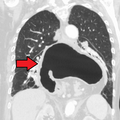Hiatal hernia
A hiatal hernia is a kind of hernia in which abdominal organs, usually the stomach, slip through the diaphragm. This may result in gastroesophageal reflux disease (or GERD) or heartburn. There are other symptoms, like dysphagia (or trouble swallowing) and chest pain. Other problems may include bowel obstruction and iron deficiency anemia.
The most common risk factors are obesity and older age.[1] Other risk factors are scoliosis, injury and several types of surgery.[2]
Between ten and eighty percent of people in the United States are affected with hiatal hernias.
The symptoms from a hiatal hernia might be improved by changes, like weight loss, changing eating patterns and raising the head of a bed.[3]
Types of hiatal hernia
Sliding hiatal hernia:- This happens when part of the stomach and the place where the stomach and esophagus meet slide up into chest through the opening (hiatus).
Paraesophageal hernia:- Happens when part of stomach pushes up through the opening (hiatus) into chest and is next to the esophagus.
Symptoms
- Burping
- Feeling nauseous
- Vomiting
- Backflow (reflux) of acid or stomach contents into the esophagus or throat
- Heartburn
- Regurgitation
- Trouble swallowing
Hiatal Hernia Media
This image was provided to Wikimedia Commons as a contribution*from an Art&Design School thanks of a collaboration between UCAC2 and Wikimedia España.
Schematic diagram of different types of hiatus hernia. Green is the esophagus, red is the stomach, purple is the diaphragm, blue is the HIS-angle. A is the normal anatomy, B is a pre-stage, C is a sliding hiatal hernia, and D is a paraesophageal (rolling) type.
A large hiatal hernia on chest X-ray marked by open arrows in contrast to the heart borders marked by closed arrows
Upper GI endoscopy depicting hiatal hernia
References
- ↑ "Hiatal Hernia". Mayo Clinic. Retrieved September 27, 2019.
{{cite journal}}: Cite journal requires|journal=(help) - ↑ "Hiatal Hernia". The Healthline. Retrieved September 27, 2019.
{{cite journal}}: Cite journal requires|journal=(help) - ↑ "How hiatal hernia is diagnosed?". Cedars-Sinai. Archived from the original on 2020-05-30. Retrieved 2021-10-20.







